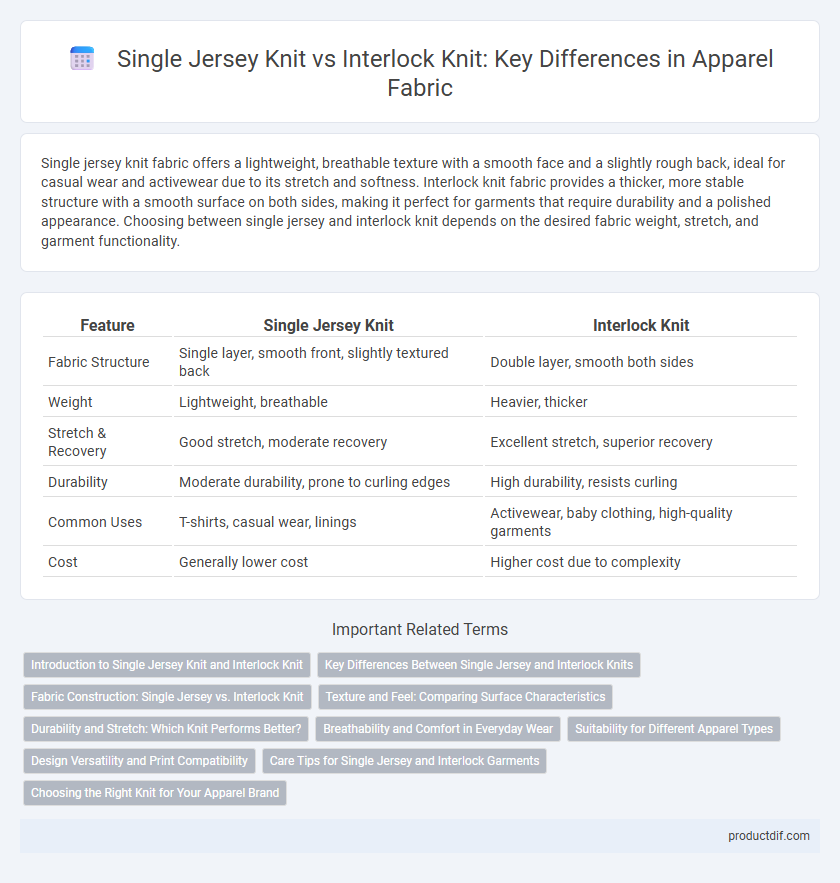Single jersey knit fabric offers a lightweight, breathable texture with a smooth face and a slightly rough back, ideal for casual wear and activewear due to its stretch and softness. Interlock knit fabric provides a thicker, more stable structure with a smooth surface on both sides, making it perfect for garments that require durability and a polished appearance. Choosing between single jersey and interlock knit depends on the desired fabric weight, stretch, and garment functionality.
Table of Comparison
| Feature | Single Jersey Knit | Interlock Knit |
|---|---|---|
| Fabric Structure | Single layer, smooth front, slightly textured back | Double layer, smooth both sides |
| Weight | Lightweight, breathable | Heavier, thicker |
| Stretch & Recovery | Good stretch, moderate recovery | Excellent stretch, superior recovery |
| Durability | Moderate durability, prone to curling edges | High durability, resists curling |
| Common Uses | T-shirts, casual wear, linings | Activewear, baby clothing, high-quality garments |
| Cost | Generally lower cost | Higher cost due to complexity |
Introduction to Single Jersey Knit and Interlock Knit
Single Jersey Knit fabric features a lightweight, breathable structure with a smooth face and slight curl at the edges, making it ideal for T-shirts and casual wear. Interlock Knit fabric offers a thicker, more stable texture with a double-layered construction that provides enhanced durability and a soft, smooth surface on both sides. Both fabrics are popular in apparel, with single jersey preferred for comfort and drape, while interlock knit delivers added warmth and shape retention.
Key Differences Between Single Jersey and Interlock Knits
Single jersey knit fabric features a lightweight and breathable structure with a smooth face and a slightly textured back, making it ideal for casual wear and t-shirts. Interlock knit fabric is thicker, denser, and more stable, offering a smoother finish on both sides and better insulation, commonly used in activewear and premium loungewear. The primary differences lie in their weight, stretch, and appearance--single jersey offers more stretch and drape, while interlock provides enhanced durability and shape retention.
Fabric Construction: Single Jersey vs. Interlock Knit
Single jersey knit features a single set of needles creating a lightweight, stretchy fabric with a smooth face and a textured backside, ideal for t-shirts and casual wear. Interlock knit uses two sets of needles producing a thicker, more stable fabric with a smooth surface on both sides, offering enhanced durability and less stretch for structured garments. The choice between single jersey and interlock knit impacts fabric weight, elasticity, and garment application, influencing comfort and performance in apparel design.
Texture and Feel: Comparing Surface Characteristics
Single jersey knit fabric features a smooth front surface with a slight curl on the edges, offering a lightweight and breathable texture ideal for casual wear. Interlock knit fabric presents a thicker, more stable structure with a consistent, smooth surface on both sides, providing a softer and more substantial feel. The denser interlock knit ensures greater durability and less stretch compared to the more flexible single jersey knit.
Durability and Stretch: Which Knit Performs Better?
Single jersey knit offers moderate stretch and lightweight comfort but is less durable due to its single-layer construction, making it prone to curling and wear over time. Interlock knit features a double-layer structure, providing enhanced durability and a firmer stretch recovery, which makes it better suited for garments requiring long-lasting shape retention. For apparel demanding both longevity and resilient elasticity, interlock knit outperforms single jersey knit in durability and stretch performance.
Breathability and Comfort in Everyday Wear
Single Jersey Knit offers superior breathability due to its lightweight, porous structure, making it ideal for warm weather and active wear. Interlock Knit, with its denser, double-layered fabric, provides enhanced softness and durability, ensuring comfort and warmth for everyday wear in cooler conditions. Choosing between these knits depends on balancing ventilation needs and a smooth, luxurious feel for optimal all-day comfort.
Suitability for Different Apparel Types
Single jersey knit fabric offers lightweight breathability ideal for t-shirts, casual wear, and summer garments, while interlock knit features a thicker, more stable structure suited for activewear, lingerie, and baby clothing. Single jersey's natural stretch and softness make it perfect for fitted apparel with drape, whereas interlock knit provides durability and a smooth surface, enhancing shape retention in dress shirts and sportswear. Choosing between single jersey and interlock knit depends on the required fabric weight, elasticity, and durability tailored to specific apparel needs.
Design Versatility and Print Compatibility
Single jersey knit offers greater design versatility with its lightweight, stretchy fabric ideal for detailed prints and complex patterns, making it preferred for casual wear and fashion-forward apparel. Interlock knit features a denser, double-layered structure that provides smooth surfaces, enhancing print clarity and durability, particularly suitable for bold graphics and high-quality print applications. The choice between single jersey and interlock knit fabric impacts the final garment's texture, print vibrancy, and overall design adaptability.
Care Tips for Single Jersey and Interlock Garments
Single jersey knit garments require gentle washing in cold water and air drying to maintain their softness and prevent fabric stretching. Interlock knit fabrics benefit from similar care but can tolerate slightly warmer water and low-heat tumble drying without losing shape or texture. Using mild detergents and avoiding excessive wringing helps preserve the durability and vibrant appearance of both single jersey and interlock apparel.
Choosing the Right Knit for Your Apparel Brand
Single jersey knit offers lightweight breathability and a smooth surface ideal for casual T-shirts and summer wear, while interlock knit provides a thicker, more durable fabric with a soft texture perfect for premium activewear and winter apparel. Evaluating your target market's needs for comfort, fabric weight, and longevity helps in selecting the appropriate knit structure that enhances your brand's quality perception. Choosing the right knit also impacts production costs and garment performance, making informed decisions essential for aligning product attributes with consumer expectations.
Single Jersey Knit vs Interlock Knit Infographic

 productdif.com
productdif.com